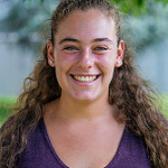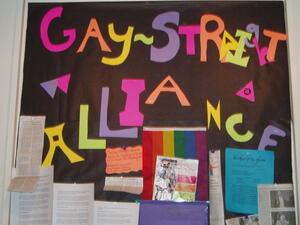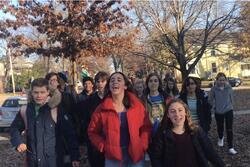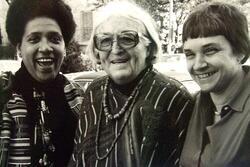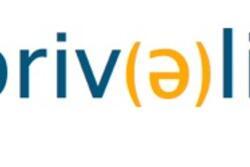An Education in Allyship
A few days before summer vacation, I got the text.
“I have to tell you something but I don’t want you to hate me,” it read. My 7th grade heart started racing. Had I accidentally said something mean about her? Was she about to tell me we couldn’t be friends anymore? What had I done wrong?
We made plans to talk the next day in person. Sitting in the middle of the crowded gymnasium at Pyle Middle School, waiting for our PE teacher to rein in the class of 40 people, she leaned in and told me, “I’m bisexual. I like guys and girls.”
At a loss for words, I just leaned in for a hug. I didn’t know whether to congratulate her or thank her. I just knew that she had taken a huge leap of faith and I wanted to be there for her in any way I could. We had only known each other for a year, but she had become one of my closest friends—a confidant and ally in the crazy world that is middle school. Her secret was safe with me, but I felt that I had to protect her at all costs. I didn’t know against what, but I was about to find out.
As we walked through the halls immediately after, I became hyper-aware of the comments my peers were making. “That outfit is so gay,” I heard someone remark to his friend. “Oh my god stop being such a f*g,” another boy yelled. I felt as though these remarks were aimed directly at my friend, though I knew that none of these people knew she was bi. But I didn’t speak up. We continued walking down the hall in silence.
The following fall she approached me with a proposal. “How would you feel about starting a Gay-Straight Alliance here at Pyle?” she asked. I knew that an 8th grader the previous year had attempted to start one, but it never really got off the ground..
“I’m in,” I responded. “What do we have to do?”
We met with our guidance counselor the following week and told her the idea. She was completely on board, but seemed apprehensive about getting parental and administrative support. She organized a meeting for us with the head of the GSA at our local high school, a strong-willed senior ready to help us in any way we needed. The four of us discussed the goals of the club: it would be a safe space for queer, questioning, and ally students in our community, as well as a place for education about sexuality, which was a taboo topic in our middle school classrooms. We talked about the importance of confidentiality and anonymity in a space like this one. The guidance counselor reminded us that starting this club would most definitely be an uphill battle, and we might face pushback. But we hoped that it would all be worth it.
Every day we became more and more aware of the necessity of this club. As word spread about what we were trying to do, a number of students told us they were in support of a GSA and would definitely participate if we succeeded in creating it. A few students approached us in confidence and came out, sharing that their identities did not feel celebrated or valued at Pyle, and that they needed a place to talk about it. A handful of students made snide remarks about the existence of a GSA—Why was it necessary? Why did we care? Did this mean we were gay?—but these comments only further emphasized the necessity of creating this club.
A few weeks later, we were finally able to meet with the principal. He informed us that he was personally in support of a GSA, but that he was worried about pushback from parents and conservative teachers. He told us that the meetings would have to be secretive, and information about the existence and logistics of the meetings would have to spread solely by word of mouth—we weren’t allowed to hang flyers or mention meetings in the daily announcements.
This took us by surprise. We knew we’d face pushback, but not quite to this extent. Sure, gay marriage had only been legal for six months on the federal level, but it had been legal in Maryland for over two years! And legality aside, Pyle was a place that prided itself on diversity. Every morning on the announcements, a student read our school values, the last two of which were “sustaining a nurturing and respectful environment” and “honoring diversity.” It seemed that these announcements every morning would boast respect and diversity yet could not discuss a club dedicated to preserving these values.
“We can’t have parents getting wind of this,” he told us. He had a point. As middle schoolers we didn’t have much mobility, and widespread parental knowledge about the GSA could potentially put students in harm’s way if they lived in homophobic households. Yet at the same time, his demands felt too restrictive. They felt like homophobia veiled as support. His assumption that students would want to conceal their involvement with a gay-straight alliance demonstrated our school’s lack of support systems for LGBTQ+ students as well as stigma around LGBTQ+ rights and personhood.
We pushed ahead with the GSA, compliant with the principal’s restrictive regulations. We reasoned that a restricted GSA was better than no GSA, and ran with the little freedom we were given. The first Thursday we met, a solid 25 students showed up to the meeting. A number of them came out at that meeting, or have since come out as LGBTQ+. Many straight allies showed up, as well. The enthusiasm from both of these groups validated our original goal: We had created a space where students could openly discuss and celebrate diversity of sexuality.
We had GSA meetings every Thursday until the end of the school year. We mixed lesson plans with open discussions, careful to honor confidentiality and allow students enough anonymity to remain comfortable. By the end of the year, a group of 6th and 7th graders were attending the meetings as well; we entrusted this group with the future of the club. The Pyle Middle School GSA exists to this day, and remains a safe space for LGBTQ+ students and allies.
A number of adults have since approached me and remarked how brave it was of me to start this club. I don’t believe I was the brave one in this experience, as I didn’t have anything to lose. I possess the privilege of being able to say, “I’m the S in GSA.” The bravery is that of my LGBTQ+ peers who came to the meetings and opened up about their lived experiences, helping to foster a more supportive network for questioning and closeted students. The bravery is that of my good friend and co-founder of the GSA for serving as a role model to both our peers and future students yet to pass through the middle school. I simply saw a problem that needed to be addressed, and used my privilege to help elevate the voices of those who had been forced to remain voiceless in our community. That’s not bravery, it’s responsibility.
This piece was written as part of JWA’s Rising Voices Fellowship.

